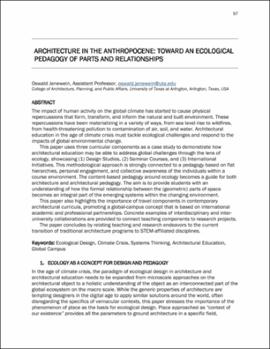| dc.contributor.author | Jenewein, Oswald | |
| dc.date.accessioned | 2022-03-23T20:44:52Z | |
| dc.date.available | 2022-03-23T20:44:52Z | |
| dc.date.issued | 2022 | |
| dc.identifier.citation | Jenewein, Oswald, "Architecture in the Anthropocene: Toward an Ecological Pedagogy of Parts and Relationships," in Person, Angela M., Anthony Cricchio, and Stephanie Z. Pilat, eds. 2022. Proceedings of Schools of Thought: Rethinking Architectural Pedagogy, Norman, Oklahoma, March 5-7, 2020. University of Oklahoma Libraries: ShareOK. | |
| dc.identifier.uri | https://hdl.handle.net/11244/335060 | |
| dc.description | This paper was presented at the 2020 Schools of Thought Conference hosted by the Christopher C. Gibbs College of Architecture at the University of Oklahoma. | |
| dc.description.abstract | The impact of human activity on the global climate has started to cause physical repercussions that form, transform, and inform the natural and built environment. These repercussions have been materializing in a variety of ways, from sea level rise to wildfires, from health-threatening pollution to contamination of air, soil, and water. Architectural education in the age of climate crisis must tackle ecological challenges and respond to the impacts of global environmental change. This paper uses three curricular components as a case study to demonstrate how architectural education may be able to address global challenges through the lens of ecology, showcasing (1) Design Studios, (2) Seminar Courses, and (3) International Initiatives. This methodological approach is strongly connected to a pedagogy based on flat hierarchies, personal engagement, and collective awareness of the individuals within a course environment. The content-based pedagogy around ecology becomes a guide for both architecture and architectural pedagogy. The aim is to provide students with an understanding of how the formal relationship between the (geometric) parts of space becomes an integral part of the emerging systems within the changing environment. This paper also highlights the importance of travel components in contemporary architectural curricula, promoting a global-campus concept that is based on international academic and professional partnerships. Concrete examples of interdisciplinary and inter-university collaborations are provided to connect teaching components to research projects. The paper concludes by relating teaching and research endeavors to the current transition of traditional architecture programs to STEM-affiliated disciplines. | |
| dc.language.iso | en_US | |
| dc.relation.ispartof | 2020 Schools of Thought Conference | |
| dc.relation.uri | https://hdl.handle.net/11244/335058 | |
| dc.rights | CC BY-NC-SA | |
| dc.rights.uri | https://creativecommons.org/licenses/by-nc-sa/4.0/ | |
| dc.subject | ecological design | |
| dc.subject | climate crisis | |
| dc.subject | systems thinking | |
| dc.subject | architectural education | |
| dc.subject | global campus | |
| dc.title | Architecture in the Anthropocene: Toward an Ecological Pedagogy of Parts and Relationships | |
| dc.type | Article | |
| dc.description.peerreview | Yes | |
| dc.identifier.doi | 10.15763/11244/335060 | |
| ou.group | Christopher C. Gibbs College of Architecture | |


